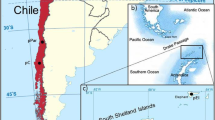Abstract
Allozyme electrophoresis was used to study the genetic variability (proportion of polymorphic loci and heterozygosity) in insular populations (Corsica, Elba, Montecristo, Marettimo, Pantelleria) of the lacertid lizardPodarcis sicula. These populations were presumed to have originated from episodes of accidental anthropogenic introduction. In order to test the hypothesis of a man-aided colonization and to provide comparative data, heterozygosity and polymorphism were also estimated in autochthonous populations ofP. sicula from the Italian peninsula and Sicily. In each case, the presumed introduced population showed levels of genetic variability significantly lower than those detected in the autochthonous ones. Very little genetic differentiation was found among native and presumed colonist populations, Nei's standard genetic distances ranging from 0.001 to 0.009. These results strongly support the hypothesis thatP. sicula was only recently introduced to the studied islands, and provide additional evidence of reduced genetic variability due to founder effect in insular populations originating from episodes of human transportation.
Similar content being viewed by others
References
Carson, H. L., Genetics103 (1978) 465.
Carson, H. L., and Kaneshiro, K. Y., A. Rev. Ecol. Syst.7 (1976) 311.
Carson, H. L., and Templeton, A. R., A. Rev. Ecol. Syst.15 (1984) 97.
Paik, Y. K., and Sung, K. C., in: Islands Ecosystems, p. 455. Eds D. Muller-Dombois, K. W. Bridges, and H. L. Carson. Hutchinson Ross, Stroudsbourg 1981.
Patton, J. L., Yang, S. Y., and Myers, P., Ecuador. syst. Zool.24 (1975) 296.
Nei, M., Maruyama, T., and Chackraborty, R., Evolution29 (1975) 1.
Gorman, G. C., and Kim, Y. J., J. Herpet.12 (1978) 47.
Soulè, M., A. Rev. Ecol. Syst.4 (1973) 165.
Selander, R. K., in: Molecular Evolution, p. 21. Ed. F. J. Ayala. Sinauer Associates Inc., Sunderland, Massachusetts 1976.
Gorman, G. C., Soulè, M., Yang, S. Y., and Nevo, E., Evolution29 (1975) 52.
Prakash, S., Genetics72 (1972) 143.
Prakash, S., Lewontin, R. C., and Hubby, J. L., Genetics61 (1969) 841.
Saura, A., Halkka, O., and Lokki, J., Genetica44 (1973) 459.
Selander, R. K., and Kaufman, D. W., Proc. natl Acad. Sci. USA70 (1973) 186.
Bonnell, M. L., and Selander, R. K., Science184 (1974) 908.
Webster, T. P., Selander, R. K., and Yang, S. Y., Evolution26 (1972) 523.
Henle, K., and Klaver, C. J. J., in: Handbuch der Amphibien und Reptilien Europas, vol. 2/II, Echsen (Sauria) III (Lacertidae III:Podarcis), p. 254. Ed. W. Böhme. AULA-Verlag. Wiesbaden 1986.
Nevo, E., Gorman, G. C., Soulè, M., Yang, S. Y., Clover, R., and Jovanović, V., Oecologia10 (1972) 183.
Capula, M., in: Proc. Sixth Ord. Gen. Meet. S. E. H., p. 89, Eds Z. Korsós and I. Kiss. Hungarian Natural History Museum, Budapest 1991.
Arnold, E. N., and Burton, J. A., A Field Guide to the Reptiles and Amphibians of Britain and Europe. Collins, London 1978.
Lanza, B., Lav. Soc. ital. Biogeogr. (N.S.)3 (1973) 755.
Lanza, B., Lav. Soc. ital. Biogeogr. (N.S.)8 (1983) 723.
Lanza, B., Bull Ecol.19 (1988) 163.
Corti, C., Ricerche sulla variabilità morfologica e genetica dellaPodarcis sicula (Rafinesque, 1810) dell'Arcipelago Toscano (Reptilia, Lacertidae). Tesi di Laurea (Dissertation Thesis), Università degli studi di Firenze, Firenze 1988.
Mayer, W., and Tiedemann, F., Amphibia-Reptilia6 (1985) 163.
Capula, M., Ricerche sulla struttura genetica diPodarcis sicula, P. wagleriana eP. filfolensis (Reptilia: Lacertidae): aspetti tassonomici ed evolutivi. Ph.D. Thesis, Università degli studi di Bologna, Bologna 1990.
Capula, M., Biochem. Syst. Ecol.21 (1993) 373.
Nei, M., Genetics89 (1978) 583.
Nei, M., Am. Nat.106 (1972) 283.
Rogers, I. S., Studies in Genetics7, Univ. Texas Publ.7213 (1972) 145.
Swofford, D. L., and Selander, R. K., J. Hered.72 (1981) 281.
Sneath, P. H. A., and Sokal, R. R., Numerical Taxonomy. W. H. Freeman & Co., San Francisco 1973.
Rogers, I. S., Syst. Zool.19 (1984) 52.
Capula, M., Biol. J. Linn. Soc.52 (1994) in press.
Mayer, W., Zool. Anz.207 (1981) 151.
Soulè, M., in: Molecular Evolution, p. 60. Ed. F. J. Ayala. Sinauer Associates Inc., Sunderland, Massachusetts 1976.
Gilpin, M. E., and Soulè, M., in: Conservation Biology: The Science of Scarcity and Diversity, p. 77. Ed. M. Soulè. Sinauer Associates Inc., Sunderland, Massachusetts 1996.
Author information
Authors and Affiliations
Rights and permissions
About this article
Cite this article
Capula, M. Population genetics of a colonizing lizard: Loss of variability in introduced populations ofPodarcis sicula . Experientia 50, 691–696 (1994). https://doi.org/10.1007/BF01952876
Received:
Accepted:
Issue Date:
DOI: https://doi.org/10.1007/BF01952876




